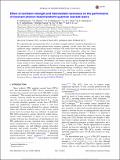Effect of oscillator strength and intermediate resonance on the performance of resonant phonon-based terahertz quantum cascade lasers
Author(s)
Fathololoumi, S.; Dupont, E.; Wasilewski, Z. R.; Chan, Chun Wang Ivan; Razavipour, S. G.; Laframboise, Sylvain R.; Huang, Shengxi; Hu, Qing; Ban, D.; Liu, H. C.; ... Show more Show less
DownloadHu_Effect of oscillator.pdf (2.879Mb)
PUBLISHER_POLICY
Publisher Policy
Article is made available in accordance with the publisher's policy and may be subject to US copyright law. Please refer to the publisher's site for terms of use.
Terms of use
Metadata
Show full item recordAbstract
We experimentally investigated the effect of oscillator strength (radiative transition diagonality) on the performance of resonant phonon-based terahertz quantum cascade lasers that have been optimized using a simplified density matrix formalism. Our results show that the maximum lasing temperature (T max) is roughly independent of laser transition diagonality within the lasing frequency range of the devices under test (3.2–3.7 THz) when cavity loss is kept low. Furthermore, the threshold current can be lowered by employing more diagonal transition designs, which can effectively suppress parasitic leakage caused by intermediate resonance between the injection and the downstream extraction levels. Nevertheless, the current carrying capacity through the designed lasing channel in more diagonal designs may sacrifice even more, leading to electrical instability and, potentially, complete inhibition of the device's lasing operation. We propose a hypothesis based on electric-field domain formation and competition/switching of different current-carrying channels to explain observed electrical instability in devices with lower oscillator strengths. The study indicates that not only should designers maximize T max during device optimization but also they should always consider the risk of electrical instability in device operation.
Date issued
2013Department
Massachusetts Institute of Technology. Research Laboratory of ElectronicsJournal
Journal of Applied Physics
Publisher
American Institute of Physics
Citation
Fathololoumi, S., E. Dupont, Z. R. Wasilewski, C. W. I. Chan, S. G. Razavipour, S. R. Laframboise, Shengxi Huang, Q. Hu, D. Ban, and H. C. Liu. “Effect of Oscillator Strength and Intermediate Resonance on the Performance of Resonant Phonon-Based Terahertz Quantum Cascade Lasers.” Journal of Applied Physics 113, no. 11 (2013): 113109.
Version: Final published version
ISSN
00218979